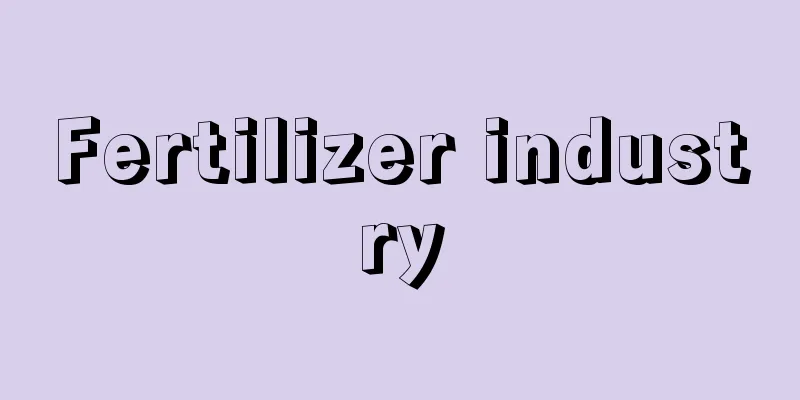Fertilizer industry

|
An industry that produces organic and chemical fertilizers (inorganic fertilizers) used in agriculture and horticulture. Organic fertilizers include fish fertilizer (fish oil residue), rapeseed oil cake, soybean meal, rice bran, bone meal, and chicken manure. Fish fertilizer, which was once the main source of production, has declined significantly due to the decline in fishery resources such as herring and sardines, and its specific weight has dropped significantly along with farmers' self-produced fertilizers (compost, manure, night soil, green manure, wood ash, etc.), and the term fertilizer now generally refers to chemical fertilizers. These components, nitrogen (N), phosphorus (P), and potassium (K), are known as the three elements of fertilizer, and fertilizers produced with only one element are called "simple fertilizers." Nitrogen fertilizers include ammonium sulfate, urea, ammonium chloride, lime nitrogen, and ammonium nitrate. Phosphorus fertilizers (phosphorus is supplied as a compound of phosphorus and oxygen to enhance the fertilizer effect) include superphosphate, fused phosphate fertilizer, burnt phosphorus, and magnesium superphosphate. Potassium fertilizers (potassium is the industrial name for potassium) include potassium chloride and potassium sulfate. Compound fertilizers that contain two or more elements are called "compound fertilizers." These include chemical fertilizers made by chemical manipulation of the ingredients, and compound fertilizers that are simply mixed together. Among chemical fertilizers, highly chemical fertilizers contain 30% or more of the three elements in total, and NK chemical fertilizers contain only nitrogen and potassium. Japan produces simple fertilizers and compound fertilizers, excluding potassium fertilizers. Potassium fertilizers are imported from Canada, Russia, and other countries because there is no production of potassium salt domestically. Phosphorus is also dependent on imports because the raw material, phosphate rock, is not produced. Between nitrogenous fertilizers and phosphate fertilizers, nitrogenous fertilizers account for a larger proportion of both production and demand. Furthermore, most nitrogenous fertilizers are supplied in the form of ammonia. The atmospheric nitrogen fixation method used in the manufacturing process is a technologically advanced modern form, and Japan's chemical industry has developed through the development and accumulation of this technology. Before World War II, the ammonia industry and the nitrogenous fertilizer industry were used as synonyms, and were also industries that represented the entire chemical industry. While Japan's demand for fertilizer is gradually decreasing, the global demand for fertilizer continues to grow as a result of rising national incomes due to economic development in newly industrialized countries and rising food demand due to global population growth, and as a result, the area of land under cultivation is increasing. [Hiroaki Aoki and Hideo Otake] HistoryThe chemical fertilizer industry began in 1839 when J.B. Rhodes of England patented superphosphate after treating bone meal with sulfuric acid. This led to the industrialization of the production of superphosphate using phosphate rock. In 1905, the production of lime nitrogen was industrialized in Italy using the Frank and Caro type nitriding oven invented in Germany (patented in 1898), and in 1913, the production of synthetic ammonium sulfate was industrialized with the establishment of ammonia synthesis technology using the Haber-Bosch process (patented in 1909), which had a revolutionary impact on the development of the chemical industry in the 20th century. Ammonia also becomes nitric acid when oxidized, which is an important raw material for the production of gunpowder, and since World War I, many countries have focused on protecting and nurturing it for military purposes. [Hiroaki Aoki and Hideo Otake] The development of Japan's fertilizer industryUntil the early 20th century, Japan's fertilizer industry was centered on organic fertilizers, but as a result of the Russo-Japanese War, imports of soybean meal from the continent were cut off, and the production of superphosphate developed rapidly. However, the technology and equipment were still very immature. The nitrogen fertilizer industry also began when Tokyo Gas recovered ammonia, a by-product of coal distillation, to produce ammonium sulfate, and full-scale industrialization began in 1910 (Meiji 43) when Nippon Nitrogen Fertilizer (now Chisso; in 2011, all production operations were transferred to its subsidiary JNC) introduced the Franck-Caro process and produced calcium carbonate nitrogen at its Minamata plant. However, farmers at the time were not accustomed to using calcium carbonate nitrogen, so they broke it down by blowing in steam to produce metamorphic ammonium sulfate. World War I led to the interruption of by-product ammonium sulfate imports from the UK, and Japan's ammonium sulfate industry monopolized the domestic market, and both by-product and metamorphic ammonium sulfate expanded rapidly. However, after the end of the war, the establishment of ammonia synthesis methods in Western countries brought about a crisis that completely destroyed the foundations of Japan's ammonium sulfate industry. As a result, there was a shift from the calcium carbonate method to the ammonia synthesis method, and each company introduced technology from Europe and the United States and realized production. From then until World War II, the industry developed rapidly thanks to the large-scale, cheap supply of electricity, the aggressive management policies of the zaibatsu conglomerates, and the generous protective policies of the military. The Second World War caused serious damage to the ammonium sulfate industry, including the shift of production to munitions, deterioration of facilities, and damage from war damage (54.1% of damage was caused by air raids). However, after the war, the need to increase food production led to a focus on production of the ammonium sulfate industry as a key production sector alongside coal and steel. With national protection (reconstruction loans, provision of price difference subsidies, and investment of corresponding funds, etc.), the industry quickly recovered and recovered to prewar levels in 1950 (Showa 25), ahead of other industries. In 1955, the fertilizer industry as a whole accounted for 41% of the chemical industry's production value. At one point, there was overproduction, but the ammonia and urea mass-produced by the petrochemical industry expanded the fertilizer industry smoothly, thanks to domestic demand and export efforts to Southeast Asia and other regions. However, after that, the oil crisis caused a sharp rise in raw material prices, and the entry of foreign companies using natural gas as a raw material into the export market caused the Japanese fertilizer industry to lose its international competitiveness, leading to a sharp decline in exports. In addition, domestic demand declined due to a worsening agricultural environment in the domestic market, including stable rice prices, fluctuations in agricultural product prices, and rising material costs. [Hiroaki Aoki and Hideo Otake] Current status of the domestic fertilizer industryIn order to revitalize the industry as one driven by domestic demand, structural improvements were implemented under the Law for Temporary Measures for the Stabilization of Specified Depressed Industries (Law for Temporary Measures for the Stabilization of Specified Industries) promulgated in 1978 and the Law for Temporary Measures for the Structure Improvement of Specified Industries (Law for Temporary Measures for the Structure Improvement of Specified Industries) promulgated in 1983, and as a result of production adjustments such as reductions in facilities, the production capacities of ammonia and urea were reduced to 48% and 31%, respectively, before the implementation of these measures. In addition, excess facilities for phosphate fertilizer and chemical fertilizer were disposed of, and companies formed alliances and mergers were carried out. However, in addition to the sluggish domestic demand, the rapid appreciation of the yen from 1985 led to a sharp increase in imports, so that from 1988 to 1989, further structural adjustments were made to urea, soluble phosphate fertilizer, advanced chemical fertilizer, and wet-process phosphoric acid under the Law for Temporary Measures for the Facilitation of Industrial Structure Transformation (Facilitation Law) (established in 1987). The 1964 Fertilizer Price Stabilization Temporary Measures Act, which established price agreements between producers and distributors of ammonium sulfate, urea, and highly chemical fertilizers, was abolished in 1989 due to criticism of the widening gap between domestic and foreign prices caused by the strong yen and the rigidity of high prices. In 1995, the Temporary Measures Act for Facilitating Business Innovation by Specified Business Operators promoted the transformation and consolidation of businesses, and this law was succeeded in 1999 by the Special Measures Act for the Revitalization of Industrial Vitality. However, although the number of businesses primarily engaged in chemical fertilizer manufacturing has decreased, there are still 155 businesses as of 2009, with many of them being small and medium-sized businesses. Nitrogen fertilizers in Japan are produced using ammonia derived from petrochemicals, while phosphate and potassium fertilizers are produced from overseas raw materials. 80% of domestic distribution is through channels (routes) operated by agricultural cooperatives. Domestic demand for fertilizer was 2.34 million tons (amount of fertilizer components; same below) in 1979, but it continued to decline, fluctuating around 1.3 million tons in the 2000s, and falling below 1 million tons in 2008 due to the impact of the global rise in raw material prices. Production volume has also been steadily declining since peaking at about 3.32 million tons (amount of nitrogen, phosphorus, and potassium components; same below) in 1974, and has been below 1 million tons since 2000. As a result of the decline in domestic demand, imports have also declined from a peak of 1.109 million tons (1987) to 709,000 tons (2005). The import ratio of domestic demand is 13% for nitrogen fertilizer and 54% for phosphate fertilizer (2008). Exports have declined since peaking at about 1.75 million tons in 1972, and have remained at around 200,000 tons (amount of components) since 1992. Most of this is nitrogen fertilizer, and 90% of the exports of ammonium sulfate, the largest export fertilizer, are destined for Malaysia, the Philippines, and Vietnam. The reasons for the decline in domestic fertilizer demand include the decline in the agricultural population and the decline in cultivated land area due to aging, the suppression of fertilizer application, the increase in imported agricultural products, consumers' preference for organic agricultural products, and environmental conservation-oriented agriculture. However, a certain amount of fertilizer is required to ensure a stable supply of food. The reasons for the increase in the import prices of raw materials such as phosphate rock, urea, and potassium chloride since 2008 include the increase in food demand due to the increase in the world's population, changes in eating habits due to the economic development of newly industrialized countries such as BRICs (Brazil, Russia, India, and China), the increase in production due to the rise in grain prices and increased demand for biofuels, and the uneven distribution of phosphate rock and potassium chloride resources. China, the United States, Morocco, and Russia produce phosphate rock, while Canada, Russia, Belarus, and Germany produce 70% of the world's potassium chloride. In addition, the decline in harvests due to climate change on a global scale invites an inflow of speculative funds, which is a destabilizing factor in the supply of fertilizer. Regarding phosphorus, in order to ensure a stable supply, the development and import of chemical fertilizers through a joint venture with a Jordanian state-run company began in earnest in 1997. Mitsui & Co. also began producing phosphate rock in Peru in 2010, and Zennoh (the National Federation of Agricultural Cooperative Associations), which imports more than half of Japan's imports of phosphate rock, ammonium phosphate, and potassium chloride, is diversifying its sources of phosphate rock to Vietnam, Tunisia, and other countries, making various efforts to ensure a stable supply of fertilizer to Japan. Meanwhile, Taiheiyo Cement and Onoda Chemical Co. jointly developed technology in 2011 to recover the phosphorus contained in large quantities in sewage and turn it into fertilizer, making it possible to secure a certain amount of phosphorus domestically. Securing fertilizer is an issue for all countries to meet in order to provide food to their citizens. In order to secure a stable supply of potassium and phosphorus, diversification of import regions is required through development investments such as resource exploration. In addition, Zennoh and fertilizer manufacturers will need to contribute to local food production by producing locally through joint ventures with local companies and providing fertilization techniques, while also making efforts such as importing products. Meanwhile, domestically, it is necessary to continue to build efficient production, logistics, and sales systems through mergers and alliances, and strengthen the management base. Since 2000, reduced fertilizer cultivation has gradually spread, and in 2000, the "Organic JAS" for organic agricultural products was established, and organic cultivation began to expand, albeit slightly. In the same year, the "Food Recycling Law" (Law on the Promotion of Recycling, etc. of Food Recycling Resources) was enacted, creating an environment that promotes composting of waste generated from food-related industries and businesses. Also, from around the same time, active research has been conducted on fertilization techniques related to reduced fertilizer cultivation using slow-release fertilizers and fertilizer-controlling fertilizers. These methods prevent the loss of nitrogen fertilizer due to rainfall, and of course they suppress eutrophication of rivers due to nitrogen runoff, but they also eliminate the need for top dressing, contributing to the economics of agriculture and helping to reduce the labor of farmers. In addition, the use of BB fertilizer (bulk blending fertilizer = a fertilizer that is simply a physical mixture of two or more types of fertilizer ingredients, and is low-cost fertilizer without the need for processes such as crushing, blending, granulation, and drying. It is easy to design the blend based on the results of soil diagnosis) is also expanding. As such, fertilizers are becoming more functional and diversified, and it is expected that the supply side will continue to contribute to individual farmers, who are the consumers, by commercializing high-performance and labor-saving fertilizers, as well as by developing businesses that offer fertilization techniques based on soil analysis, so that efficient agricultural production can be achieved even if the number of fertilizer applications is reduced. [Hideo Ohtake] "Research on Chemical Fertilizers" by Ando Junpei (1975, Nisshin Publishing)" ▽ "New Edition of Chemical Fertilizers" edited by the Chemical Society of Japan (1977, Dainippon Tosho)" ▽ "Dictionary of Inspections by Industry, Vol. 3 (1996, 2008) edited and published by the Institute for Financial Affairs" ▽ "Pocket Fertilizer Handbook 2009" edited by the Agricultural Product Safety Management Division, Consumer Affairs and Safety Bureau, Ministry of Agriculture, Forestry and Fisheries (2010, Agriculture and Forestry Statistics Association)" ▽ "Chemical Industry White Paper" 2010 edition, 2011 edition (2010, 2011, special edition of the monthly Chemical Economy)" ▽ "Chemical Business Guide" edited and published by the Chemical Daily Co., Ltd. ▽ "Fertilizer Yearbook" edited and published by the Fertilizer Association Newspaper Department, various years' editions" [References] | | | | |Source: Shogakukan Encyclopedia Nipponica About Encyclopedia Nipponica Information | Legend |
|
農業や園芸用で使用する有機質肥料と化学肥料(無機質肥料)を生産する工業。有機質肥料には魚肥(魚油の搾りかす)、菜種油かす、大豆かす、米糠(こめぬか)、骨粉、鶏糞(けいふん)などがあるが、かつてその生産の中心であった魚肥が、ニシンやイワシなどの漁業資源の減少で大幅に減退、農家の自給肥料(堆肥(たいひ)、厩肥(きゅうひ)、下肥(しもごえ)、緑肥、草木灰など)とともに比重は著しく低下し、通常肥料といえば化学肥料をさすようになった。この成分である、窒素(N)、リン(P)、カリウム(K)は肥料の3要素といわれ、1要素のみで製造されているものを「単味肥料」(単肥)という。窒素単肥には硫安(硫酸アンモニウム)、尿素、塩安(塩化アンモニウム)、石灰窒素、硝安(硝酸アンモニウム)などが、リン酸(リンは肥料効果を高めるため、リンと酸素の化合物として供給される)単肥には過リン酸石灰、溶成リン肥、重焼リン、苦土過リン酸石灰などがあり、カリ肥料(カリはカリウムの工業的通称名)には塩化カリウム、硫酸カリウムなどがある。2要素以上含むものを「複合肥料」といい、これには、成分を化学的操作によって製造した化成肥料と、単に混和した配合肥料がある。化成肥料のなかの高度化成肥料は3要素の合計成分量が30%以上のもの、NK化成肥料は窒素とカリだけを含有するものである。日本で生産されるのはカリ肥料を除いた単味肥料と複合肥料で、カリ肥料は国内にカリ塩を生産しないため、カナダ、ロシアなどから輸入している。またリンも、原料のリン鉱石を産出しないため、輸入に依存している。 窒素肥料とリン酸肥料では、生産・需要とも窒素肥料の比重が高い。また、ほとんどの窒素肥料はアンモニアの形で供給される。製造工程の空中窒素固定法は技術的にきわめて優れた近代的形態で、日本の化学工業はその技術開発と蓄積によって発展した。第二次世界大戦前においては、アンモニア工業と窒素肥料工業が同義語として用いられるとともに、化学工業全体を代表する工業でもあった。 日本の肥料需要は漸減しているが、新興工業国の経済発展による国民所得の増加や、世界的人口増加などによる食料需要増加に伴って作付面積は増加し、肥料の世界的需要は増加し続けている。 [青木弘明・大竹英雄] 沿革化学肥料工業の始まりは、1839年イギリスのJ・B・ローズが骨粉を硫酸で処理し、過リン酸石灰として特許を得たことが最初で、その後リン鉱石を原料とする過リン酸石灰の製造が工業化される原因となった。窒素肥料では1905年ドイツで考案されたフランク‐カロ法(Frank and Caro type nitriding oven)による石灰窒素の製造がイタリアで工業化され(特許は1898年)、さらに1913年ハーバー‐ボッシュ法(Haber-Bosch process)によるアンモニア合成技術の確立によって合成硫安の生産が工業化され(特許は1909年)、20世紀の化学工業の発展に画期的な影響をもたらした。またアンモニアは酸化すると硝酸となり、火薬製造の重要な原料となるため、第一次世界大戦を契機として各国とも軍事的目的からその保護育成に力を傾注した。 [青木弘明・大竹英雄] 日本の肥料工業の発展日本の肥料工業は20世紀の初期までは有機質肥料が中心であったが、日露戦争の結果、大陸の大豆かす輸入が途絶したことによって過リン酸石灰の製造が急速に発達した。しかし技術および設備はきわめて幼稚であった。また窒素肥料工業は東京瓦斯(ガス)が石炭乾留の副生アンモニアを回収して硫安を製造したのが端緒で、本格的な工業化は1910年(明治43)日本窒素肥料(現、チッソ。2011年生産事業はすべて子会社JNCに譲渡)がフランク‐カロ法を導入して水俣(みなまた)工場で石灰窒素の生産を行ったのが最初である。しかし当時の農民は石灰窒素の使用に慣れていなかったため、水蒸気を吹き込んで分解し、変成硫安とした。第一次世界大戦はイギリスからの副生硫安輸入の途絶を招いたため、日本の硫安工業は国内市場を独占し、副生・変成硫安とも急速な拡大を示した。しかし大戦終結後の、欧米諸国におけるアンモニア合成法の成立は、日本の硫安工業の基礎を根底から瓦解(がかい)させる危機を招いた。その結果、石灰窒素法からアンモニア合成法への移行が進捗(しんちょく)し、各社とも欧米から技術を導入して、その生産が実現した。以後第二次世界大戦に至るまで、電力の大量・安価な供給や財閥などの積極的な経営政策と軍部の手厚い保護政策によって急速に発展した。 第二次世界大戦は、直接軍需品への生産転換、設備の老朽化、戦災による被害(空襲による被害率54.1%)など硫安工業を著しく荒廃させたが、戦後は食糧増産の必要から石炭、鉄鋼と並んで基幹生産部門として傾斜生産が行われた。国家的な保護(復金融資、価格差補給金の支給、見返り資金の投入など)のもとでいち早く復興し、他産業に先駆けて1950年(昭和25)には戦前水準を回復、肥料工業全体として1955年には化学工業生産額の41%を占めるに至った。一時、過剰生産も生じたが、石油化学工業により大量生産されたアンモニア、尿素は、内需と東南アジアなどへの輸出努力により順調に肥料工業を拡大させた。しかしその後、オイル・ショックによって原料価格が高騰し、さらに天然ガスを原料とする諸外国の企業の輸出市場への参入は、日本の肥料工業の国際競争力を失わせたため、輸出は激減した。また国内市場も米価の据置き、農産物価格の乱高下、資材高騰などの農業環境の悪化で内需は低下した。 [青木弘明・大竹英雄] 国内肥料工業の現状内需中心の産業として活性化させる目的で、1978年(昭和53)公布の「特定不況産業安定臨時措置法(特安法)」と1983年公布の「特定産業構造改善臨時措置法(産構法)」によって構造改善が実施され、設備削減などの生産調整が図られた結果、アンモニアと尿素の生産能力はそれぞれ実施前の48%と31%まで縮小した。またリン酸肥料や化成肥料でも過剰設備の処理や企業の提携、合併などが行われた。しかし内需の低迷に加え、1985年からの急激な円高により輸入が急増したため、1988~1989年にかけ尿素、溶成リン肥、高度化成肥料および湿式リン酸は「産業構造転換円滑化臨時措置法(円滑化法)」(1987年成立)によりさらに構造調整が進められた。1964年制定の「肥料価格安定臨時措置法」による硫安、尿素、高度化成肥料の生産・販売業者間での価格取決めは、円高による内外価格差の拡大や高値硬直への批判から1989年(平成1)に廃止された。1995年からは「特定事業者の事業革新の円滑化に関する臨時措置法」により事業の転換、集約化が進められ、この法律は1999年より「産業活力の再生特別措置法」に引き継がれている。しかし減少したとはいえ化学肥料製造を主とする事業所数は2009年(平成21)時点で155あり中小零細事業者が多い。 日本の窒素肥料の生産は石油化学からのアンモニアによって製造され、リン酸肥料とカリ肥料は海外原料から製造されている。国内流通は8割が農協系統のチャネル(経路)である。 肥料の国内需要は1979年には234万トン(肥料成分量。以下同じ)であったが、減少を続け2000年代に入ると130万トン前後を推移し、2008年には世界的な原料価格高騰の影響で100万トンを割り込むに至った。生産量もまた1974年の約332万トン(窒素、リン、カリの成分量。以下同じ)を頂点に一貫して減少を続け、2000年以降100万トンを割り込んでいる。内需減少の影響では、輸入も110.9万トン(1987)のピークから、70.9万トン(2005)へ減少している。内需に対する輸入割合は窒素肥料が13%、リン酸肥料は54%(2008)である。輸出は1972年の約175万トンを頂点に減少し、1992年以降は20万トン前後(成分量)で推移している。そのほとんどは窒素肥料であり、最大の輸出肥料である硫安の輸出量の9割はマレーシア、フィリピン、ベトナム向けである。 国内の肥料需要の減少の背景としては、高齢化による農業人口の減少や作付面積の減少、施肥量の抑制、輸入農産物の増加、消費者の有機農産物指向と環境保全型農業などがあげられる。しかし、食料の安定供給のためには一定量の肥料を必要とする。2008年からのリン鉱石、尿素、塩化カリなどの原料輸入価格の高騰の背景には、世界の人口増加による食糧需要の増加、BRICs(ブリックス)(ブラジル、ロシア、インド、中国)など新興工業国の経済発展による食生活の変化、バイオ燃料向け穀物価格の高騰や需要増を背景とする生産拡大と、リン鉱石と塩化カリの資源偏在の問題がある。リン鉱石は中国、アメリカ、モロッコ、ロシアの4か国で、塩化カリはカナダ、ロシア、ベラルーシ、ドイツの4か国で世界の7割を産出している。また世界的規模で起こる気候変動による収穫の減少は投機資金の流入を誘い、肥料供給上の不安定要因となっている。リンについては、その安定供給のためヨルダンの国営企業との合弁による化成肥料の開発輸入が1997年に本格化した。また三井物産は2010年からペルーでリン鉱石の生産を開始し、リン鉱石、リン安(リン酸アンモニウム)、塩化カリ輸入量の半分以上を輸入する全農(全国農業協同組合連合会)は、リン鉱石の調達先をベトナム、チュニジアなどへ分散化させるなど、日本の肥料供給安定に向けてさまざまな努力が行われている。他方、太平洋セメントと小野田化学工業は、2011年に共同で、下水中に大量に含まれるリンを回収し、肥料化する技術を開発したため、リンは一定量、国内で確保することが可能となった。 国民への食糧供給のため、肥料の確保はすべての国の課題である。カリやリンの安定的確保には、資源探索などの開発投資による輸入地域の多角化が求められる。また、全農や肥料メーカーが現地企業との合弁などにより現地で生産し、施肥技術の提供を伴う形で地元の食糧生産に貢献するとともに、製品を輸入するなどの努力が必要であろう。一方国内では、今後も合併、提携などにより効率的な生産・物流・販売体制を築き、経営基盤を強化することが必要とされている。2000年以降、減肥栽培が徐々に広まっているが、2000年には有機農産物の「有機JAS(ジャス)」が定められ、わずかではあるが有機栽培が拡大し始めるとともに、同年制定された「食品リサイクル法」(食品循環資源の再生利用等の促進に関する法律)によって、食品にかかわる産業や事業から排出される廃棄物の堆肥化も促進される環境となった。また同時期から、緩効性肥料、肥効調節型肥料による減肥栽培に関する施肥技術の研究が盛んに行われている。これらは降雨による窒素肥料の流失を防ぐが、流失窒素による河川の富栄養化を抑制することはもちろん、追肥が不要となり農業の経済性に貢献し、農家の労力軽減に資することになる。さらに、各農家の耕作地の土壌分析と栽培作物を前提に、その土壌に必要とされる成分を混合して供給されるBB肥料(Bulk Blending肥料=2種類以上の肥料原料を物理的に混合しただけで、粉砕・配合・造粒・乾燥などの工程がなくコストが安い肥料。土壌診断結果に基づいた配合設計が簡単にできる)も利用が拡大中である。このように肥料は高機能化、多様化しており、施肥の回数を減らしても生育段階に応じて必要な肥料が効果を発揮し効率的な農業生産が可能となるよう、供給サイドには需要家である個別農家に対し、今後も高機能型・省力型肥料の製品化はもちろん、土壌分析に基づく施肥技術提案とセットになった事業展開などで貢献することが期待される。 [大竹英雄] 『安藤淳平著『化学肥料の研究』(1975・日新出版)』▽『日本化学会編『新版化学肥料』(1977・大日本図書)』▽『金融財政事情研究会編・刊『業種別審査事典』第3巻(1996、2008)』▽『農林水産省消費・安全局農産安全管理課監修『ポケット肥料要覧 2009』(2010・農林統計協会)』▽『化学工業日報社編・刊「化学工業白書」2010年版、2011年版(2010、2011・月刊『化学経済』臨時増刊号)』▽『化学工業日報社編・刊『ケミカルビジネスガイド』各年版』▽『肥料協会新聞部編・刊『肥料年鑑』各年版』 [参照項目] | | | | |出典 小学館 日本大百科全書(ニッポニカ)日本大百科全書(ニッポニカ)について 情報 | 凡例 |
<<: Microbalance (microscale) - Biryotembin (English spelling) micro balance
Recommend
Intaglio (English spelling)
A term for sculpture. From the Italian, it means i...
Pais, SBCda S. (English spelling) PaisSBCdaS
…Official name: Portuguese RepublicRepública Port...
New Orleans (English spelling)
A city in Louisiana, USA. It is located on the nor...
Caprolactam - Caprolactam (English spelling)
A lactam (cyclic amide). It is also called 5-amin...
OBIYASHINAI - Don't be afraid
...In later generations, Shichi-ya became the mos...
OCR - Optical Character Recognition
Optical character recognition. It is the process o...
Philipp Scheidemann
German politician. Born in Kassel. After working ...
Via Valeria
One of the important ancient Roman roads that conn...
Walking role - Kachiyaku
… The burden of carrying horses is called "T...
Umrah - Umra
…Hajj must be performed in a group in a set order...
mille-fleurs (English spelling) millefleurs
…The mille-fleurs (thousand-flower pattern) tapes...
Kallisthenes (English spelling)
…Alexander largely followed the old system, activ...
Electroplating (Electroplating) - Denki plating (English spelling)
When the object to be plated and the counter elect...
Masakatsu Inaba
Year of death: January 25, 1634 (February 22, 1634...
Armstrong, HE (English spelling) ArmstrongHE
…So, since the mid-19th century, the teaching met...







![Higashisefuri [village] - Higashisefuri](/upload/images/67cc999b07bd0.webp)

